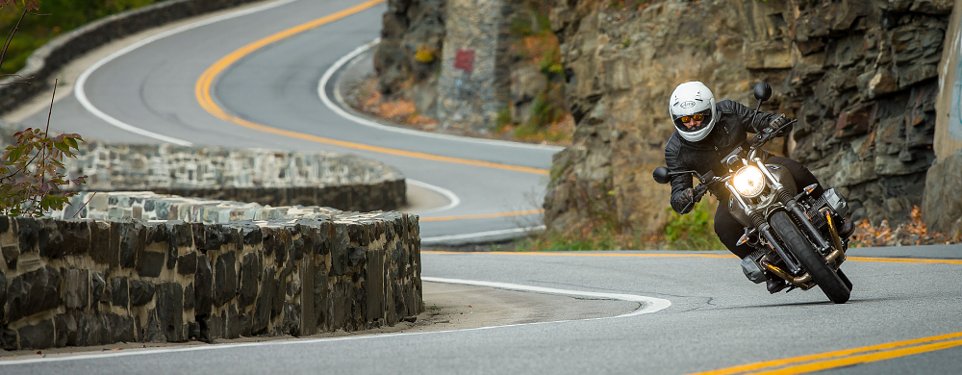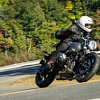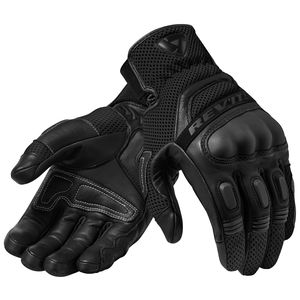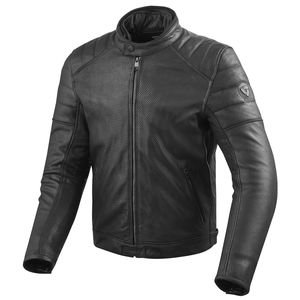Leave it to BMW to show up fashionably late to the hippest party in town.
The R nineT Scrambler is the second BMW in their Heritage line, and with an MSRP of $13,000, consumers will either see it as the most affordable entry into their “R” line of boxer-engine motorcycles, or the most expensive “Scrambler” on the market.
The target demographic for this bike seems to be a combination of older Millennials and younger Generation Xers. Folks who are old enough to realize just how cool their parents really were. From retro furniture to vinyl records (and now cassette tapes?), what's old is new again and motorcycles are no exception. BMW has been noticeably void of models which embrace the company's past while addressing the future and this new demographic of motorcyclists.

The question is, will this new addition to their heritage line measure up to the expectations of BMW stalwarts while attracting a new generation of riders who place a premium on cool?
The bike
Stop for a second and pretend that this bike isn’t called a Scrambler (don’t worry, we’ll get to that). Look at the bones of what you are getting and consider why it’s important in the world of BMW.
While they look similar at face value, there's a long list of changes from the original R nineT that accounts for not only the stylistic differences, but also the nearly $2,100 reduction in MSRP. Among other things, the brakes, suspension, wheels, tank, exhaust, and frame have all been altered to set this bike apart from its older brother.

One of the most notable changes is the loss of the large, radial-mounted, monobloc calipers found up front on the R nineT in favor of a pair of four-piston axial-mounted Brembos squeezing 320 mm discs. A two-piston caliper with a 265 mm rotor wraps up braking at the rear. ABS is standard with the Scrambler and can be disabled with the push of a button for those times when it’s cool to slide that rear end to a halt in the gravel like you’re riding a large BMX bike.

Combine that with steel braided lines and adjustable levers and this bike slows to a stop just fine, despite the changes over the R nineT. It doesn’t have that massive bite you get with the bigger calipers, but you don’t need that on this bike. Braking is still strong and progressive with good feedback at the lever and this alteration allows BMW to cut costs.
Handling is another story. BMW claims that changes were made for “a neutral cornering response” but the front end feels a bit vague, if not downright lazy, especially at lower speeds. I overheard some folks complaining about the front suspension but I see the altered steering geometry as the culprit (28.5 degrees of rake compared to the 25.5 degrees on the R nineT). This is amplified at slow speeds by a non-adjustable steering damper, which provides a bit too much initial resistance. Talking with Shawn Thomas, a product expert for BMW, he said that the off-road-oriented Metzeler Karoo 3 tires on the press bikes didn’t help matters and that handling is improved when utilizing street tires (as all of our bikes were outfitted with Karoo 3s, we didn’t have the opportunity to test this theory).

The Scrambler gets a traditional, non-adjustable, telescopic fork from Showa up front with 4.9 inches of travel and while the rear Sachs shock increases travel to 5.5 inches over the R nineT, the only adjustment is for preload. Even with the extra travel, it’s not enough to soak up the spine-jarring bumps when you’re ripping down a pothole-laden gravel road at 70 mph (I’ve got a bent front rim to prove it). The suspension is geared toward the sportier side of riding and is sprung more for a Spurgeon-sized rider at 205 pounds than someone a few pounds lighter.

Factor in the new 19-inch wheel up front and a wheelbase spanning 60.1 inches, and the result is that the Scrambler prefers long sweeping curves to tight technical twisties. The upside being that it is quite stable at highway speeds. After the press intro ended in New Jersey, I got to ride one back to Philly and I cruised comfortably at 80 mph down I-95.

The one thing that hasn’t changed is the heart of the machine. The Scrambler is powered with the same 1,170 cc air/oil-cooled boxer engine pumping out 110 horsepower at 7,750 rpm and 86 foot-pounds of torque at 6,000 rpm. You’ll have to use the rev-limiter to find the 8,500 rpm redline because there is no tachometer. Unlike the R nineT, the Scrambler now meets Euro 4 emissions standards, thanks to a revised fuel map.
At $13,000, I would love to see a few additional niceties, such as a fuel gauge, tachometer, and some suspension adjustability. Keep in mind that if you are going to add optional features such as the cross-spoked wheels ($500), Automatic Stability Control (ASC) ($400), and heated grips ($250) which our test bikes had, you’ll be looking at a number just over $14,000. The one thing I'll say for BMW is while I am sure there are people out there who will rack up the add-ons, other than upgrading to the cross-spoked wheels (which let you use tubeless tires), I think this bike is just fine as is.

The changes to the Scrambler are important for the German motorcycle manufacturer because it now provides the skeleton for an entry-level boxer motorcycle in their lineup. Consider the MSRP is only slightly higher than something like a Triumph T-120, take into account the performance gains, and it helps to put that $13,000 price tag into perspective. Especially after Tuesday’s announcement that BMW will be building two additional bikes, the Pure and the Racer, on the Scrambler's revised R nineT platform.
Riding the BMW R nineT Scrambler
In order to showcase this new Scrambler, BMW led us on a scenic ride of northern New Jersey and into southern New York State. It was great to have all the Californians come out to my neck of the woods for a change. We motored down some of my favorite stretches of local, East Coast riding just south of the Catskill Mountains. We also took a tour through Manhattan and into Brooklyn at rush hour, which is the antithesis of good East Coast riding.

The revised ergonomics of the Scrambler provided a comfortable, standard riding position for the street. Slightly higher bars coupled with slightly lowered pegs provided for a comfortable position for my six-foot, three-inch frame. The taller 32.3-inch seat height was perfect for me but might be a bit high for shorter riders. It would feel a lot like my old Bonneville T-100, if my Triumph had better power, brakes, throttle response, suspension, and electronic options.
Like I mentioned earlier, the Scrambler prefers long, fast sweeping curves to tight, aggressive ones. It didn’t instill confidence right out of the gate, there was a bit of a learning curve. Once out in the country, away from low-speed stop-and-go traffic, the Scrambler fell into its element. Whereas the front end felt bulky and cumbersome around town and through tighter turns, it felt planted and smooth on country roads.

I was worried that the revised fuel map would dull some of the spirit of this engine, but I was impressed with how sharply the throttle responded. The big boxer twin with massive torque is easily my favorite part of the motorcycle. If you’ve never ridden a boxer before, the shaft-jacking takes a little bit of getting used to, especially when you’re shifting under aggressive acceleration.
I point this out because, according to BMW, nine percent of the folks who bought an R nineT bought it as their first bike. BMW would surely like to see the Scrambler increase that number, especially considering the lower price. On one hand, the responsible side of me thinks this bike is a bit overkill for a first machine. On the other hand, I can understand why the aesthetic appeal of this machine attracts new riders into the fold. We've seen the same thing with the Ducati Scrambler and the Yamaha XSR900, for example.

My biggest concern is for both new and current riders who have never taken a motorcycle off-road and are looking at the Scrambler as the potential vessel for their maiden voyage into the world of dirt. Don’t do it. This is a road bike with available knobby tires. If you have experience riding big bikes off-road, you can wrestle this thing down a stretch of dirt or a gravel path, but it’s not ideal. BMW was extremely open and upfront in the fact that despite the styling, this is a street bike that is much more at home on a winding country road than scrambling down a dirt trail. The problem for new and beginning riders is that they might not be aware of the distinction.
While the newly redesigned Akrapovic high-mount mufflers look the part and sound great, the bars are too short to properly stand up, the footpegs are back a bit too far, and the tank is way too slippery to get any grip with your knees. You’re also about three inches of suspension travel shy of something like an F 800 GS.
If you are going to be daring and give it a whirl, at the very least I recommend going with the optional tubeless cross-spoke rims (a cool option that isn’t available on the R nineT with its 17-inch rims). You’ll also want to consider some tank grip pads and a skid plate to protect your oil pan. Also, if you opted for the optional ASC (Automatic Stability Control), you’re going to want to make sure you turn it off before heading into the wild. The list could easily continue but, as I am not encouraging you to treat this like an adventure bike, I am going to stop right there.
The proliferation of “Scrambler” models
With this new variation of the R nineT, we now have five OEMs (Triumph, Ducati, Moto Guzzi, and Yamaha make up the other four) on the market with a bike in their lineup called a “Scrambler.” In fairness, Yamaha abbreviates theirs to “SCR,” but they’re not fooling anyone. I think it’s time to declare an end to this naming convention.

Talking with my riding buddy and head of RevZilla’s video department, Brett Walling, he mentioned he would have preferred they call it “The Ruffian" (or literally anything else). Really, what we’re seeing is just a different flavor of retro styling for those folks who prefer their vintage-influenced machine to be a bit more Malcolm Smith and a little less Mike Hailwood.
We had a question come through on RevZilla's Instagram page which asked, “Just because they call it a Scrambler, does that mean we have to treat it like one?”
The answer is a resounding “No.” Just because this bike is called a “Scrambler” does not mean you have to use it as an off-road rocketship. In fact, you probably shouldn’t. This bike is an exercise in style that cuts some of the unnecessary, high-end, go-fast bits off of the R nineT while still maintaining the performance and quality one would expect from a BMW.
Final thoughts
“This is not your father’s BMW,” seems to be the encompassing message from a company striving to attract new and younger riders to their brand. While I get that they're trying to come across as a little less "RT" and a little more "RR," I think BMW is missing an opportunity when it comes to this new heritage line of motorcycles. This could be the BMW to cross that generational divide. The BMW that you and your father (or mother) can agree on.

The Scrambler is void of over the top, hi-tech, gizmotronics, while retaining a few choice tech upgrades, and all of the soul of a boxer twin for riders who want classic styling. It’s also an effort by BMW to take a step toward making their product more attainable financially. It’s clear that BMW is serious about cutting costs to reach a wider audience without diluting the quality of their product.

Strip away the Scrambler name and the heritage marketing and what you are left with is a standard BMW in the boxer family with retro lines we haven’t seen from the company in some time.
Showing up late to the party is a hell of a lot better than not showing up at all.































 Riders Preferred Membership
Riders Preferred Membership



















